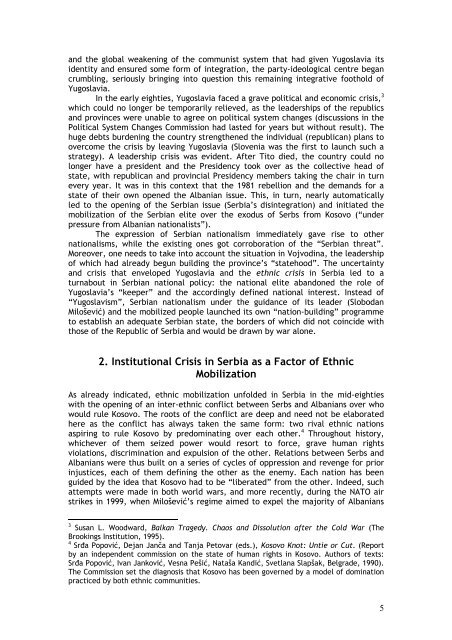Ethnic Mobilization in Serbia - EURAC
Ethnic Mobilization in Serbia - EURAC
Ethnic Mobilization in Serbia - EURAC
Create successful ePaper yourself
Turn your PDF publications into a flip-book with our unique Google optimized e-Paper software.
and the global weaken<strong>in</strong>g of the communist system that had given Yugoslavia its<br />
identity and ensured some form of <strong>in</strong>tegration, the party-ideological centre began<br />
crumbl<strong>in</strong>g, seriously br<strong>in</strong>g<strong>in</strong>g <strong>in</strong>to question this rema<strong>in</strong><strong>in</strong>g <strong>in</strong>tegrative foothold of<br />
Yugoslavia.<br />
In the early eighties, Yugoslavia faced a grave political and economic crisis, 3<br />
which could no longer be temporarily relieved, as the leaderships of the republics<br />
and prov<strong>in</strong>ces were unable to agree on political system changes (discussions <strong>in</strong> the<br />
Political System Changes Commission had lasted for years but without result). The<br />
huge debts burden<strong>in</strong>g the country strengthened the <strong>in</strong>dividual (republican) plans to<br />
overcome the crisis by leav<strong>in</strong>g Yugoslavia (Slovenia was the first to launch such a<br />
strategy). A leadership crisis was evident. After Tito died, the country could no<br />
longer have a president and the Presidency took over as the collective head of<br />
state, with republican and prov<strong>in</strong>cial Presidency members tak<strong>in</strong>g the chair <strong>in</strong> turn<br />
every year. It was <strong>in</strong> this context that the 1981 rebellion and the demands for a<br />
state of their own opened the Albanian issue. This, <strong>in</strong> turn, nearly automatically<br />
led to the open<strong>in</strong>g of the <strong>Serbia</strong>n issue (<strong>Serbia</strong>’s dis<strong>in</strong>tegration) and <strong>in</strong>itiated the<br />
mobilization of the <strong>Serbia</strong>n elite over the exodus of Serbs from Kosovo (“under<br />
pressure from Albanian nationalists”).<br />
The expression of <strong>Serbia</strong>n nationalism immediately gave rise to other<br />
nationalisms, while the exist<strong>in</strong>g ones got corroboration of the “<strong>Serbia</strong>n threat”.<br />
Moreover, one needs to take <strong>in</strong>to account the situation <strong>in</strong> Vojvod<strong>in</strong>a, the leadership<br />
of which had already begun build<strong>in</strong>g the prov<strong>in</strong>ce’s “statehood”. The uncerta<strong>in</strong>ty<br />
and crisis that enveloped Yugoslavia and the ethnic crisis <strong>in</strong> <strong>Serbia</strong> led to a<br />
turnabout <strong>in</strong> <strong>Serbia</strong>n national policy: the national elite abandoned the role of<br />
Yugoslavia’s “keeper” and the accord<strong>in</strong>gly def<strong>in</strong>ed national <strong>in</strong>terest. Instead of<br />
“Yugoslavism”, <strong>Serbia</strong>n nationalism under the guidance of its leader (Slobodan<br />
Milošević) and the mobilized people launched its own “nation-build<strong>in</strong>g” programme<br />
to establish an adequate <strong>Serbia</strong>n state, the borders of which did not co<strong>in</strong>cide with<br />
those of the Republic of <strong>Serbia</strong> and would be drawn by war alone.<br />
2. Institutional Crisis <strong>in</strong> <strong>Serbia</strong> as a Factor of <strong>Ethnic</strong><br />
<strong>Mobilization</strong><br />
As already <strong>in</strong>dicated, ethnic mobilization unfolded <strong>in</strong> <strong>Serbia</strong> <strong>in</strong> the mid-eighties<br />
with the open<strong>in</strong>g of an <strong>in</strong>ter-ethnic conflict between Serbs and Albanians over who<br />
would rule Kosovo. The roots of the conflict are deep and need not be elaborated<br />
here as the conflict has always taken the same form: two rival ethnic nations<br />
aspir<strong>in</strong>g to rule Kosovo by predom<strong>in</strong>at<strong>in</strong>g over each other. 4 Throughout history,<br />
whichever of them seized power would resort to force, grave human rights<br />
violations, discrim<strong>in</strong>ation and expulsion of the other. Relations between Serbs and<br />
Albanians were thus built on a series of cycles of oppression and revenge for prior<br />
<strong>in</strong>justices, each of them def<strong>in</strong><strong>in</strong>g the other as the enemy. Each nation has been<br />
guided by the idea that Kosovo had to be “liberated” from the other. Indeed, such<br />
attempts were made <strong>in</strong> both world wars, and more recently, dur<strong>in</strong>g the NATO air<br />
strikes <strong>in</strong> 1999, when Milošević’s regime aimed to expel the majority of Albanians<br />
3<br />
Susan L. Woodward, Balkan Tragedy. Chaos and Dissolution after the Cold War (The<br />
Brook<strong>in</strong>gs Institution, 1995).<br />
4<br />
Srđa Popović, Dejan Janča and Tanja Petovar (eds.), Kosovo Knot: Untie or Cut. (Report<br />
by an <strong>in</strong>dependent commission on the state of human rights <strong>in</strong> Kosovo. Authors of texts:<br />
Srđa Popović, Ivan Janković, Vesna Pešić, Nataša Kandić, Svetlana Slapšak, Belgrade, 1990).<br />
The Commission set the diagnosis that Kosovo has been governed by a model of dom<strong>in</strong>ation<br />
practiced by both ethnic communities.<br />
5

















